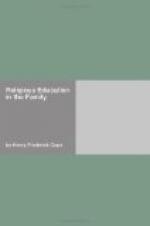Thirdly, help him to will the right. Help him to feel that he must choose for himself, to recognize the power of the will and the grave responsibilities of its use. He is entering the realm of the freedom of the will. Every act of deliberate choice, with your aid, in a sense of the seriousness of choice, goes to establish the character that does not drift, is not dragged, and will not go save with its whole selfhood of feeling, knowing, choosing, and willing.
Sec. 3. ANGER
An angry child is a child in rebellion. Rebellion is sometimes justifiable. Anger may be a virtue. You would not take this force out of your child any more than you would take the temper out of a knife or a spring. Anger manifested vocally or muscularly is the child’s form of protest. But, established as a habit of the life, it is altogether unlovely. Who does not know grown-up people who seem to be inflexibly angry; either they are in perpetual eruption or the fires smoulder so near the surface that a pin-prick sets them loose. Usually a study of their cases will show either that the attitude of angry opposition to everything in life has been established and fostered from infancy or that it was acquired in the adolescent period.
The angry, antisocial person is most emphatically an irreligious person; there can be no love of his brother man where that spirit is. The home is the place where this ill can best be met and cured, for it deals most directly with the infant, and for the adolescent it is the best school of normal social living.
Let no one think the angry demonstrations of little children are negligible or that they have nothing to do with the religious character of the child or the adult. They are important for at least two reasons, first, as furnishing the angry one opportunity to acquire self-control, to master his own spirit, and, secondly, because they disturb the peace and interfere with the well-being of others.
It is possible to set up habits of anger in the cradle. In the first instance the infant encountered opposition in the cradle and proceeded to conquer it by yelling, and so, day after day, he found anger the only route to the satisfaction of his desires. He grew to take all life in terms of a bitter struggle and every person became his natural enemy.
In the case of the adolescent it sometimes happens that a boy or a girl will make a very tardy passage through the normal experience of social aversion, the time when they seem to suspect all other people, to flee from social intercourse and to sulk, to want to be off in a corner alone. This is a normal phase of adolescent adjustment, coming at thirteen or fourteen, but it ought to pass quickly. A few allow this period to become lengthened; they fail to regain social pleasure and soon drift into habits of social enmity. This may be due to scolding at this period, or to a lack of healthful friendships.




